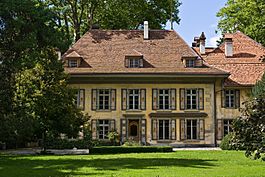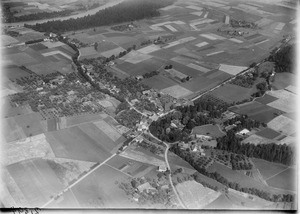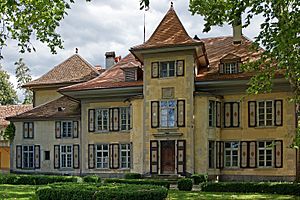Kiesen facts for kids
Quick facts for kids
Kiesen
|
||
|---|---|---|

Kiesen Castle
|
||
|
||
| Country | Switzerland | |
| Canton | Bern | |
| District | Bern-Mittelland | |
| Area | ||
| • Total | 4.69 km2 (1.81 sq mi) | |
| Elevation | 547 m (1,795 ft) | |
| Population
(Dec 2020 )
|
||
| • Total | 1,012 | |
| • Density | 215.8/km2 (558.9/sq mi) | |
| Postal code |
3629
|
|
| Surrounded by | Heimberg, Jaberg, Oppligen, Uttigen, Wichtrach | |
| Twin towns | Zeliv (Czech Republic) | |
Kiesen is a small town, also called a municipality, in Switzerland. It is located in the Bern-Mittelland administrative district within the canton of Bern. Kiesen is known for its interesting history and beautiful natural surroundings.
Contents
History of Kiesen
People have lived in the Kiesen area for a very long time! The oldest sign of human settlement is a stone ax from the neolithic period (New Stone Age). Other old items, like tools from the late Bronze Age and Roman coins, have also been found here.
The village of Kiesen was first officially mentioned in the year 1236. Back then, a large part of the village belonged to a place called Interlaken Monastery. Later, in the 1300s, different noble families from the city of Bern owned parts of Kiesen.
In 1579, a big fire destroyed most of the buildings in the village. About a hundred years later, in 1668, a wealthy family built a large country house. It was built on the remains of an old medieval castle. This house changed owners a few times before the Effinger family bought it in 1776. They rebuilt the house into what it looks like today in 1793.
The First Cheese Maker
In 1815, a man named Rudolf Emanuel Effinger built a dairy and cheese shop on the estate. This was very important because it was the first cheese maker in the entire Canton of Bern! This dairy encouraged farmers all over the canton to start dairy farming in the 1800s. It helped the cheese industry in Bern grow a lot. The estate later became a Dairy Museum in 1974.
Modern Changes
For a long time, Kiesen had its own system to control floods from the rivers. In 1830, a bridge was built over the river, which replaced the old ferry boat. A dock was also built for boats.
In 1859, a train station was built in Kiesen, connecting it to Bern and Thun. Even with the train, the village kept its traditional look until 1971. That's when the A6 motorway (a big highway) was built. This project changed the area, moving some farms and draining marshy lands. Since the 1980s, many people who work in nearby cities have moved to Kiesen because it's easy to travel from there.
Geography of Kiesen
Kiesen covers an area of about 4.7 square kilometers (about 1.8 square miles).
- More than half of this area (53%) is used for farming.
- About 26.7% is covered by forests.
- Around 17.9% has buildings or roads.
- A small part (2.8%) is rivers or lakes.
Kiesen is located where the Chisen and Rotachen Rivers flow into the larger Aare River.
In 2010, Kiesen became part of a new administrative area called Verwaltungskreis Bern-Mittelland.
Kiesen's Coat of Arms
A coat of arms is a special design that represents a town, family, or organization. Kiesen's coat of arms has a golden background. It shows a black "merchant's mark," which is like a special symbol used by traders. This mark is placed between two red flames that rise from a green hill with three bumps.
People of Kiesen (Demographics)
Kiesen has a population of about 870 people (as of December 2011).
- Most people in Kiesen (about 95.4%) speak German as their first language.
- Other languages spoken include Albanian and Serbo-Croatian.
In 2011, about 22% of the people in Kiesen were children and teenagers (0–19 years old). Adults (20–64 years old) made up 66.2% of the population, and seniors (over 64 years old) were 11.8%.
The chart below shows how Kiesen's population has changed over many years:

Important Heritage Sites
The Schlossgut, which includes Kiesen Castle, is a very important historical site in Switzerland. It is listed as a heritage site of national significance. This means it's a place with special historical or cultural value that needs to be protected.
Economy and Jobs
In Kiesen, people work in different types of jobs:
- Primary sector: About 34 people work in this sector, mostly in farming. There are about 12 businesses related to farming.
- Secondary sector: Around 66 people work in this sector, which includes manufacturing (making things) and construction (building things). There are 11 businesses in this area.
- Tertiary sector: The largest group, 298 people, work in this sector. This includes jobs in shops, restaurants, transportation, education, and healthcare. There are 41 businesses in this sector.
Many people who live in Kiesen travel to other towns for work. In 2000, about 25% of working people used public transportation, and nearly 48% used a private car to get to their jobs.
Religion in Kiesen
Based on information from 2000:
- Most people (about 75.5%) belong to the Swiss Reformed Church.
- About 11.5% are Roman Catholic.
- A smaller number of people belong to other Christian churches or are Islamic.
- Some people do not belong to any church.
Climate in Kiesen
Kiesen gets a good amount of rain and snow each year.
- Between 1981 and 2010, Kiesen had rain or snow on about 128 days each year.
- The total amount of precipitation (rain or snow) was about 1018 millimeters (about 40 inches) per year.
- August was usually the wettest month, with about 128 millimeters of rain or snow.
- February was the driest month, with about 49 millimeters of precipitation.
Education in Kiesen
The school system in the Canton of Bern works like this:
- Kids can attend one year of non-required Kindergarten.
- Then, they go to six years of Primary school.
- After that, there are three years of mandatory lower Secondary school. Students are grouped based on their abilities.
- After lower Secondary, students can choose to continue their education or start an apprenticeship (learning a trade on the job).
During the 2010–2011 school year, 81 students attended classes in Kiesen. There was one kindergarten class with 11 students and four primary classes with 70 students.
Kiesen also has its own public library, called Gemeindebibliothek Kiesen. In 2008, the library had 4,471 books and other media.
See also
 In Spanish: Kiesen para niños
In Spanish: Kiesen para niños






